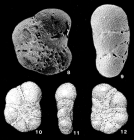WoRMS taxon details
Bisaccioides Collins, 1981
531384 (urn:lsid:marinespecies.org:taxname:531384)
accepted
Genus
Bisaccioides cuspatus Collins, 1981 (type by original designation)
- Species Bisaccioides cuspatus Collins, 1981
- Species Bisaccioides cuspata Collins, 1981 accepted as Bisaccioides cuspatus Collins, 1981 (Genus is masculine)
marine, brackish, fresh, terrestrial
recent + fossil
masculine
Collins, A. C. (1981). Holocene foraminiferida from the Fitzroy River Estuary, North West Australia. <em>Memoirs of the National Museum Victoria.</em> 42(1): 1-6., available online at https://www.biodiversitylibrary.org/part/50186#/summary
page(s): p. 4 [details] Available for editors [request]
[request]
page(s): p. 4 [details] Available for editors
Hayward, B.W.; Le Coze, F.; Vachard, D.; Gross, O. (2025). World Foraminifera Database. Bisaccioides Collins, 1981. Accessed through: World Register of Marine Species at: https://www.marinespecies.org/aphia.php?p=taxdetails&id=531384 on 2025-05-06
Date
action
by
![]() The webpage text is licensed under a Creative Commons
Attribution 4.0 License
The webpage text is licensed under a Creative Commons
Attribution 4.0 License
Nomenclature
original description
Collins, A. C. (1981). Holocene foraminiferida from the Fitzroy River Estuary, North West Australia. <em>Memoirs of the National Museum Victoria.</em> 42(1): 1-6., available online at https://www.biodiversitylibrary.org/part/50186#/summary
page(s): p. 4 [details] Available for editors [request]
[request]
page(s): p. 4 [details] Available for editors
Other
additional source
Loeblich, A. R.; Tappan, H. (1987). Foraminiferal Genera and their Classification. Van Nostrand Reinhold Company, New York. 970pp., available online at https://books.google.pt/books?id=n_BqCQAAQBAJ [details] Available for editors  [request]
[request]
From editor or global species database
Diagnosis Test irregularly planispiral, bi-involute, final whorl with about six gradually enlarging and inflated chambers, umbilici covered by a perforate and pustulose plate that continues along the base of the final chamber to form a small chamberlet over the primary aperture, branches from the umbilical plate form raised bands along the sutures and connect across the test periphery to those from the opposite side, small arched openings along both sides of the sutural bands lead into the sutural canals beneath the bands, similar small openings border the plate that forms the apertural chamberlet; wall calcareous, radial, relatively thick, coarsely perforate; primary aperture interiomarginal and equatorial, covered by the plate of the apertural chamberlet, with accessory openings along the margins of the umbilical, apertural, and sutural coverplates. Holocene (estuarine); Northwest Australia. (Loeblich & Tappan, 1987, Foraminiferal Genera and Their Classification) [details]Grammatical gender 30.1.4.4. A compound genus-group name ending in the suffix -ites, -oides, -ides, -odes, or -istes is to be treated as masculine unless its author, when establishing the name, stated that it had another gender or treated it as such by combining it with an adjectival species-group name in another gender form.
Bisaccioides cuspatus Collins, 1981 is the type species (masculine), the genus is masculine. [details]

